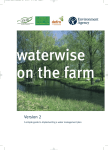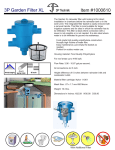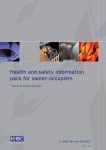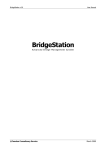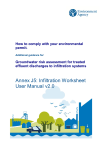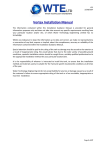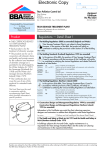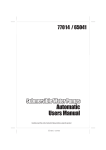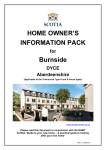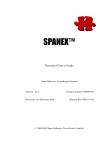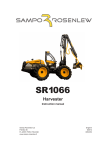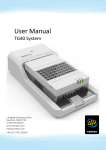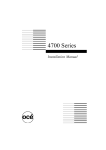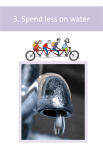Download Groundwater Protection Code: Septic Tanks
Transcript
Groundwater Protection Code: Use and construction of septic tanks and other non-mains sewerage 1 Groundwater Protection Code: Use and Construction of Septic Tanks and other Non-Mains Sewerage. CHAPTER 1 The aim of the code 1.1 Why a code? 1.2 What sort of code? 1.3 What types of non-mains sewerage systems does this code cover? 3 3 3 4 CHAPTER 2 Operating your system 2.1 The need for control 2.2 Caring for your system 2.3 Regular checks 2.4 Maintenance 5 5 5 6 6 CHAPTER 3 Design, installation and decommissioning 3.1 The need for control 3.2 Overview of process for obtaining permission 3.3 Pre-design considerations 3.4 Design 3.5 Installation 3.6 De-commissioning 9 9 9 10 11 12 13 ANNEX A Legal requirements to protect groundwater 14 ANNEX B Environment Agency contacts 15 ANNEX C Principal Risks to Groundwater from non-mains sewerage systems 17 2 CHAPTER 1 The aim of the code 1.1 Why a code? Non-mains sewerage systems can pollute groundwater (all water lying below the water table or in aquifers) if they are poorly located, built or operated. This can impact public and private space water supplies, other groundwater abstractions, and surface water in rivers, streams and lakes. Such pollution can make water unusable for drinking water and toxic to aquatic life. Once contaminated, groundwater is very difficult and expensive to make good, and for this reason there are UK and EC laws to protect it. Persons involved with non-mains sewerage systems must comply with relevant water protection legislation. Failure to do so could result in long-term contamination of valuable groundwater and as a consequence may result in serious penalties, costs and liabilities. The code gives advice to help avoid these sorts of problems. 1.2 What sort of code? The code is made under Regulation 21 of the Groundwater Regulations 1998 and approved by Ministers with the aim of providing practical guidance on protecting groundwater in England & Wales. Not complying with the code is not an offence in itself, but following the advice in the code will help to ensure that relevant water legislation, in particular the Groundwater Regulations, are complied with. In enforcing such compliance, the Environment Agency will consider whether or not the guidance in the code has been, or is likely to be, followed. A summary of the legal requirements to protect groundwater is provided at Annex A. Chapter 2 sets out advice relevant to persons owning, operating or maintaining a non-mains system. Chapter 3 contains advice for persons installing a new system, or taking a system out of service. It is up to such persons to make use of the guidance appropriately. If in doubt, you should contact your local Environment Agency office – a list of contacts is provided at Annex B. It is important to emphasise that the code relates specifically to the protection of groundwater and is not intended to address matters relating to health and safety or non-groundwater environmental issues, since these are the subject of other 3 regimes, codes and guidance. Neither is the code intended to be a comprehensive design or user-manual for non-mains sewerage systems. A general overview of the principle risks to groundwater from non-mains sewerage systems is at Annex C. You may find this helpful when following the advice in the code. 1.3 What types of non-mains sewerage systems does this code cover? The code is targeted at persons who own, install, operate, empty, maintain or decommission small non-mains sewerage operations serving individual properties and small developments. The type of systems covered include: • septic tank systems (in which partial treatment of the sewage occurs within the tank, with additional “treatment” of the effluent within a shallow drainage system) • package treatment plants (the effluent discharged to the shallow drainage system is of a higher quality than that discharged from septic tanks) • cesspools (sealed tanks with no discharge outlet) • alternative or additional treatments (e.g. reed beds and waterless toilets), and • all the drainage connecting the property to the means of treatment. The general groundwater principles in the code will also be relevant to larger non-mains sewerage systems. 4 CHAPTER 2 Operating your system You should read this chapter if you own or manage your own sewage treatment system. 2.1 The need for control Inappropriate operation and maintenance of your system will present a serious risk to groundwater, even if the system is appropriately sited, designed and installed. A general overview of the risks is given in Annex C. To avoid pollution problems you must: • be careful what you put into the system; • take time to check the system regularly; • ensure that the system is regularly maintained to keep it functioning. This chapter provides advice on these issues. 2.2 Caring for your system In order to maintain the operation of your system you need to take some simple precautions. A number of household chemicals and cleaning products can kill the helpful organisms in septic tanks, package plants and other non-mains systems that rely on biological action to treat the sewage. Oil and grease etc can also impair the treatment process. This may result in a poor quality effluent and the need to empty the tanks more often. Some of these chemicals are very polluting and their discharge to groundwater is prohibited. To avoid these problems, do not put the following down sinks, toilets or other drains that go to the septic tank/treatment plant: • • • • excess amounts of bleach, solvents (e.g. white spirit, cellulose thinners, some cleaning products), oil, grease, or fats pesticides Biologically based cleaning products, which are less harmful to sewage treatment processes, are available and may be more suitable to non-mains systems. Sys- 5 tems that provide some treatment (this does not include cesspools) operate best with a steady input. If your system is used intermittently (for example holiday accommodation) you may need to take additional precautions to prevent pollution. Specific precautions will depend on the nature of the system (consult the operators manual or maintenance company), but might include dosing the system with proprietary organisms. 2.3 Regular checks It is important that you regularly check the operation of the system. This might include: • • • • a fortnightly or monthly visual check on the discharge from system to the drainage field or discharge point. Building regulations require an inspection chamber between a septic tank/treatment plant and discharge for this purpose. The discharge from other forms of non-mains drainage should also be regularly checked. regular (monthly) checking of the level of liquid and solid in tanks ensuring the mechanisms are all working correctly (such as rotating contactors and air lift pumps) checking that sewage or effluent is not saturating the ground or flowing overland into a stream or onto another property. In order to show that you have carried out the checks properly, it is recommended that you keep records of items such as: • • • • • • the design (manufacturer and installer), age, location of system and drainage field monthly water levels in the distribution chamber other items you might include in your monthly inspection dates of tank desludging/emptying other maintenance and servicing activities recommended by the manufacturer any problems and remedies applied 2.4 Maintenance Routine. Septic tank/treatment plant: This should be emptied regularly. If it does not need emptying every year this may be because it is leaking and further investigation will be required. Cesspool: This will need emptying on average once a month. If the cesspool never or infrequently needs emptying, or if the intervals between emptying are increasing, there is likely to be a leak in the tank or pipework that should be in- 6 vestigated and repaired (see figure 1). If you have a cesspool, this is probably because the ground conditions are unsuitable for the discharge of effluent. This may be due to a number of factors but in general it is because of an increased risk of pollution of surface or groundwater, or public health risk. So a leaking cesspool is potentially a serious problem and needs rectifying quickly. Figure 1 Damage to Cesspool Cesspool. Very intensive maintenance – monthly emptying. If damaged can have release of raw sewage with little signs initially. Damaged tank causing discharge of raw sewage and potentially polluting groundwater Systems that involve pumps or moving parts: These will need regular maintenance. If you are connected to a shared system it is good practice to have a formal agreement to share the responsibility and costs of maintenance. Troubleshooting. If you notice any of the following you may have a problem with your system. The ground around your drainage area is saturated or water/effluent is flowing across the ground. This may imply that the soil has become saturated either because of rising groundwater levels, poor natural drainage of the soil or; the soil has become clogged either by the discharge from the drainage pipes or due to bio-fouling. You should investigate the cause of the problem and put remedial measures in place. This may require the use of professional specialist services. Sewage is backing up in the drains, or sinks and toilets are draining slowly. The tank may be clogged with solid material and need emptying. Alternatively the drains connecting to the system maybe blocked. This could result in damage to the pipes and loss of sewage from the pipes into the ground. This can lead to pollution. If the tank becomes too full access covers maybe pushed off and sewage released onto the ground. The tank must be emptied immediately. No outflow from the system. The tank may need emptying (see above), the influent drains to the tank maybe blocked (see above) or the tank is leaking. Establish the reason and effect a remedy. 7 Odour or unexpected fungal or bacterial growths in nearby stream or water course. This may mean that poorly treated or raw effluent is discharging to surface water. Damaged pipes or tank could be the cause as they are releasing raw sewage. Investigate, identify and resolve the problem, with the help of professional specialist services if required. Your rights to main sewerage If existing arrangements are causing, or may cause, risks to the environment, you may have rights to mains sewerage under s. 101A of the Water Industry Act 1991. Annex A provides further details. 8 CHAPTER 3 Design, installation ing and decommission- You should read this chapter if you are installing a new sewage treatment system for yourself, or having it installed for you 3.1 The need for control The location of a non-mains sewage system is an important element in preventing or minimising pollution, and correct design and construction are essential for its effective performance. De-commissioning of redundant systems needs careful consideration to avoid on-going threats to groundwater. This chapter sets out essential considerations, including key statutory controls, in carrying out any of these activities, but you should also familiarise yourself with the principal groundwater risks set out in Annex C. 3.2 Overview of process for obtaining permission Before the system can be installed, planning permission and building control approval must be obtained. Similarly, before the system may be operated a discharge consent from the Environment Agency may be required. Hence, contact should always be made with the planning officer at the local authority, the local authority building control department and the local Environment Agency office before designing and installing a new or modified system. Environment Agency contact details are given at Annex B. Planning permission is obtained either through the submission of a planning application, or deemed planning permission, granted in accordance with the Town and Country Planning General Permitted Development Order 1995. Detailed planning guidance on the selection of appropriate drainage is given in Circular 3/99 (in Wales circular 10/99 applies). A fundamental question you will need to answer is why connection to a main sewer is not proposed. Building Control approval is required to ensure adequate drainage to meet the requirements of the Building Regulations prior to construction of a non-mains sewerage system. The Regulations require as a minimum that building work be notified to the local authority and, for certain larger works, the applicant must deposit full plans with the local authority Building Control or an Approved Inspector. 9 The Building Regulations set out minimum standards for building work, and particular requirements with respect to non-mains sewerage are given. They provide for local authority inspection of foul drainage, and give periods of notice for covering up drainage systems. They also require that foul drainage should be connected to public foul sewer or combined sewer wherever reasonably practical. Pollution control Written permission from the Environment Agency is required in many cases before effluent can be disposed of to controlled waters (rivers and streams, coastal waters, groundwater and some lakes) or to land. In addition, notices can be served on anyone who is doing something, or failing to do something, such that pollution of controlled waters is likely to occur. The aim of this code is to avoid the need to serve notices specifically under the Groundwater Regulations in respect of unsatisfactory sewerage systems; nevertheless this good practice will help to protect all controlled waters. 3.3 Pre-design considerations Before deciding on an appropriate design for the system, you should consider your sewage disposal requirement and the options presented by the site. It will be necessary to carry out some investigation and testing as part of the scheme development. Those aspects that are of particular importance in protecting groundwater are: • confirm that connection to public sewer is not an option (this will be the first check for acceptability applied by the local authority) • estimate or measure the volume of the sewage that will need to be managed, and assess it’s nature • inspect the proposed site to assess the practicality of constructing the system and to identify any features that may count against a non-mains sewerage system (e.g. water supply well) • investigate to determine whether ground conditions are appropriate for the construction of a drainage field. This will involve an understanding of the percolation capacity of the ground, the minimum and typical depths to the water table, and the direction of flow of the groundwater. • Non-mains sewerage systems often rely on gravity drainage and therefore locations at a low point within a site will be preferred, however, the low point may be associated with a higher risk of flooding and a thinner unsaturated zone (high groundwater table). Where such risks are unacceptable then alternative locations may require consideration. 10 You should also be aware of the right to main sewerage under s. 101A of the Water Industry Act 1991 as outlined in Annex A. 3.4 Design Guidance on the design of a non-mains sewage treatment system is provided in the British Standard BS6297 (soon to be superseded by BS EN 12255 & 12566) and Part H of the Building Regulations, 2000. Compliance with the requirements of these documents will be taken as compliance with the design requirements of this code, though you should take particular note of the groundwater protection considerations set out in this section. If, as a result of reading this section, there are areas of uncertainty, you should refer to the Environment Agency for advice. The design of a non-mains sewerage system can be divided into design of the septic tank / package treatment plant, and design of the drainage field. The former should be fairly straightforward, depending principally on the number of users, and is not sensitive to location. The design of the drainage field, however, will have an important impact on the risk to groundwater. Drainage design Good drainage design is a key to ensuring that sewage does not end up in groundwater. The scope for the design and siting of the “drainage field” will determine the suitability of a site. The British Standard (BS6297) gives advice on ensuring that drainage fields are appropriate. However, the following points are emphasised from the point of view of groundwater protection: 1. A “drainage field” should generally be located a minimum of 50 metres from a potable water supply borehole or spring. 2. Soakaways should be avoided, particularly borehole soakaways, because they are designed for rapid inflow below the soil layer and thus provide little or no opportunity for the vital stage of additional treatment of the sewage effluent within the soil layer. 3. Use of drainage mounds (see figure 2) should be considered carefully. A drainage mound is an engineered structure to allow secondary treatment of septic tank effluent where the subsoil is occasionally waterlogged, but where drainage fields would otherwise be suitable. They cannot be used to overcome poor percolation conditions in the subsoil, since they will simply result in seepages around the ground surface. 11 The advantages of drainage mounds are; • they increase the separation distance between the disposal system and water table • they provide additional wastewater treatment. The disadvantages are; • they may be more expensive to construct • they require a relatively large land area dedicated to wastewater application only • they are only suitable for gently sloping sites of less than 7o • they are likely to require pumping equipment with additional costs. Figure 2 Drainage Mound Pump Drainage field Mound 3.5 Installation During the installation stage care should be taken to ensure that the tank is structurally sound to prevent leaks or ingress of groundwater. Tanks should have third party certification confirming their structural integrity and that they are fit for purpose. Glass-fibre and thermoplastic tanks should have an Agrément Certificate (British Board of Agrément, BBA) and pre-cast concrete tanks should satisfy the appropriate British Standard. Septic tanks should be constructed in accordance with BS EN 12566 (prefabricated tanks) or BS6297: 1983 (built in situ). Package treatment plants should meet the requirements of BS7781. Building control inspection of the installation should be carried out to ensure that it meets requirements of the Building Regulations. Alterations to existing drainage systems is a controlled service under Regulation 3 and 4 of the Building Regulations 2000 and section 61 of the Building Act 1984. You must notify such work must to the local authority. 12 3.6 De-commissioning Decommissioning is likely to occur when mains sewerage is made available, or when buildings are demolished. In some instances cesspools are permitted by the Environment Agency on the basis that they will be de-commissioned when mains sewerage becomes available. Drainage fields may need to be decommissioned where the performance has deteriorated as a result of clogging or compaction, or because new building requires the sewage facilities to be moved. The principal dangers to groundwater from decommissioning are likely to arise where not all connections are directed to the new system and remain ‘live’, and where tanks are not emptied. Thorough decommissioning should ensure that all connections to the drainage pipework are removed and that all necessary steps are taken to ensure that the pipework cannot be used for other purposes. All tanks should be emptied by a specialist contractor and made safe by infilling. 13 ANNEX A Legal requirements to protect groundwater The Water Resources Act 1991 and the Groundwater Regulations 1998 are the primary legislation protecting groundwater in England and Wales. The Act makes it an offence to cause or knowingly permit pollution of groundwater and provides the Environment Agency with powers to address pollution. The Regulations put in place a regime specifically aimed at controlling both direct and indirect discharges of listed substances to groundwater and give the Environment Agency further powers specifically to control activities in or on the land which could lead to groundwater pollution. They also allow ministers to approve codes of practice aimed at helping persons engaged in activities in or on the land comply with the Regulations. Although domestic effluent discharged from certain isolated dwellings outside drinking water abstraction areas are excluded from the scope of the Regulations, the advice in this code will still be relevant to such dwellings since they are within the scope of the Water Resources Act. Owners of non-mains sewerage systems may require an authorization or discharge consent from the Environment Agency if their system is designed to discharge to land or controlled waters (ie surface waters or groundwaters). The advice in this code will be relevant whether or not an authorization or discharge consent is required. Section 101A of the Water Industry Act 1991 places a duty on sewerage undertakers to provide a public sewer for those premises where the existing arrangements are giving, or are likely to give, rise to adverse environmental or amenity effects, and it is considered appropriate to resolve the difficulties by providing a public sewer. This means that, for example, if a septic tank can no longer function properly because of rising groundwater, the owner of the premises may be able to apply to the undertaker to be connected to the mains sewerage network. 14 ANNEX B Environment Agency contacts ENVIRONMENT AGENCY Head Office Anglian Region Southern Region Midlands Region South West Region North East Region Thames Region North West Region General Enquiry Line Emergency Hotline Rio House Waterside Drive Aztec West Almondsbury Bristol BS32 4UD Kingfisher House Goldhay Way Orton Goldhay Peterborough PE2 5ZR. Guildbourne House Chatsworth Road Worthing West Sussex BN11 1LD Sapphire East 550 Streetsbrook Road Solihull B91 1QT Manley House Kestrel Way Exeter EX2 7LQ Rivers House 21 Park Square South Leeds LS1 2QG Kings Meadow House Kings Meadow Road Reading RG1 8DQ Richard Fairclough House Knutsford Road Warrington WA4 1HG Tel. 08459 333 111 Tel. 0800 807060 www.environmentagency.gov.uk Tel. 01454 624400 Fax. 01545 624 409 Tel. 01733 371811 Fax. 01733 231840 Tel. 01903 832000 Fax. 01903 821832 Tel. 0121 7112324 Fax. 0121 7115824 Tel. 01392 444000 Fax. 01392 444238 Tel. 0113 2440191 Fax. 0113 2461889 Tel. 0118 953 5000 Fax. 0118 950 0388 Tel. 01925 653999 Fax. 01925 415961 15 Environment Agency, Wales Cambria House 29 Newport Road Cardiff CF24 0TP Tel. 01222 770088 Fax. 01222 798555 16 ANNEX C Principal Risks to Groundwater from non-mains sewerage systems Figure 3 Illustration of risks to groundwater, wells and surface water from septic tank/pakage plant systems. Soakaway (Not a recommended means of discharge) Bottom of tank damaged and leaking. Tank never needs emptying Drainage field Private water supplies from borehole to this or another property. Min 50m preferably not downstream of discharge Sewage ‘treated’ in unsaturated zone (ie above the water table). Produces a less polluting discharge to groundwater. Little or no treatment – Raw sewage enters groundwater. Little attenuation once below the water table Groundwater is at risk of pollution by sewage passing down through the ground and reaching the water table. Non-mains sewerage systems that discharge to ground are intended to do so in a controlled way via a properly designed shallow drainage field with an adequate depth of unsaturated soil between the base of the drainage field and the water table. In such systems, the gradual percolation of effluent through the unsaturated soil is an intrinsic, vital and probably the most important component of the treatment process. 17 The most common causes of increased risks to groundwater from such systems arise when: 1. A system is located in an area where the water table is too near to the ground surface to allow adequate treatment of the sewage effluent before reaching the groundwater table. 2. A system is connected to a a means of rapid infiltration such as a deep soakaway or borehole. These bypass the soil layer, again causing a risk of inadequate treatment of the effluent before reaching the water table. 3. The effluent discharged from the system retains an unacceptably high concentration of potential pollutants. This may result from any, or all, of the following: ♦ poor design, ♦ poor maintenance, ♦ overloading ♦ deterioration ♦ leakages within the system, caused accidentally during installation; through time due to a range of factors such as settlement, tree roots and other building work; or deliberately, for example by holing a cesspool in an attempt to reduce tanker removal costs ♦ poor decommissioning (i.e. pipework is still active). 18


















